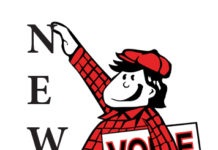Editor’s note: Each month of the school year, Tahoma asks its teachers and students to place special emphasis on one of the nine Future Ready Skills. Tahoma Matters will feature examples of how those skills are being taught in classrooms. This month’s featured skill is Creative Innovator, which can be seen in many Tahoma classrooms year-round. We’ll share more examples of Creative Innovator skills from Maple View Middle School teacher Molly Galassi’s social studies students on our website this week.
What if astronauts could stop to refuel during a trip to Mars? If the Creative Innovators on the Maple View Middle School robotics teams were designing for NASA, that’s exactly what could happen. Members of the “Spud-nik” team together tackled this season’s FIRST Lego League robotics challenge: “Identify a physical or social problem faced by humans during long duration space exploration within our Sun’s solar system and propose a solution.”
In the team’s solution, “Galactic Gas Station,” a ship carrying drones would travel ahead of the main mission, landing on an asteroid approximately halfway between Earth and Mars. The drones would mine water and ice to create hydrogen fuel, and the main mission’s rocket could then use its fuel to arrive at the asteroid two times faster before refilling for the remainder of the trip to Mars, the students explained. Power for the drones would come from solar panels.
Creating a product to solve the challenge is one piece of the four-part FIRST competition; also required are the team challenge, the board and the robot design.
“I just love this program. I wish we had more teams,” said teacher Candice Lommen, who coaches the team with teacher Justin Mullen. “It gives kids a community and a place to try their ideas out without being criticized.”
On the day of competition, student teams have three chances with their robot at the challenges on the board. In between attempts, they have the opportunity to talk to other teams about how their programs run, and incorporate some of their ideas if desired.
“That’s what this program is all about,” Lommen said, referring to the innovative thinking and continual revision of programming. “I’ve noticed the thinking level of the kids has changed quite a bit over the last eight years.”
A second team of 11 students from Maple View tackled this season’s challenge to make space travel more sustainable with a product that would grow food in space.
Maple View had 60 students interested in participating in the club this year, but the FLL limits the number of students on a team to 10 (and one alternate), so the advisers had to hold auditions and offer teamwork challenges to the students who wanted to participate, Mullen said.
During an after school club meeting this week, students from the Spud-nik team worked to refine their programming, robot design, and a presentation board about their Core Values. Seventh-grader Sadie M. was building a new arm for the robot that will be able to “grab” a set of wheels and move them.
“I’m layering it to make it strong and making a box so that they (the wheels) don’t roll everywhere,” Sadie explained.
Board captain Shane G. and other team members worked to modify the programming.
“I’m trying to make it so it’s simpler … so that it’s faster to run,” Shane explained. He also worked to troubleshoot why the robot was turning in a different direction than expected.
In preparation for the next round of competition on Jan. 20 and 21, throughout the afternoon, students repeatedly bring the robot to the competition board, run programs, then return to their computers to adjust the programming.
“Oh, that didn’t work. It turns too much,” one student commented, watching the robot in action.
Volunteer Joe Burianek has been helping out in the program for the past seven years, since his own son, who is now a senior on the Bear Metal team at THS, was in sixth grade.
“I enjoy working with the students at this level when they’re learning programming,” Burianek added.
Eighth-grader Payton K. emphasized that the team is continually using their core values: collaborative teamwork, innovation, fun and robot design.
At the board while watching teammate Kyle W. test his program, Payton said, “We believe in you!”
The robot completed the run, which the students deemed not quite right — yet.
“Let’s try again,” Kyle said.
Creative Innovator on staff
When the Tahoma High School staff heard an update about the Future Ready Skills in August and received new posters featuring the areas of focus, teacher Ken Loomis took out his scissors and cut the badges representing each skill out of his poster. Then, he laminated them and put magnets on the back for use in his classroom.
Kimberly Allison, Instructional Technology and Future Ready Skills Coordinator, heard about Loomis’ idea, and decided it was a wonderful product that all teachers could use.
“Ken gets all the credit for being a Creative Innovator,” Allison said. Sets of the magnets for the elementary level version and the secondary version of the skill set are being rolled out now.









